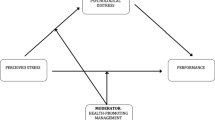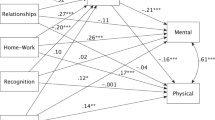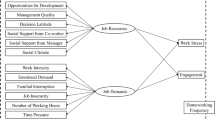Abstract
The current study examined the occupational stress-strain relationship among a sample of 109 white-collar employees in Singapore. Participants completed a survey that assessed the presence of 8 human resource practices (job training, communication, job redesign, promotional opportunities, employee involvement, family-friendly policies, pay systems, and individual-focused stress interventions [SMIs]), 2 major stressors (role overload and responsibility), 2 types of strain (vocational and interpersonal), and organizational commitment. Results indicate that human resource (HR) practices did not reduce the sources of stress (role overload and responsibility) within the workplace. However, there was a direct negative relationship between HR practices and interpersonal strain. In particular, family-friendly practices, job training, and SMIs reduced interpersonal strain. An examination of vocational strain showed that it was negatively associated with SMIs and job training. In addition, organizational commitment mediated the relationship between HR practices and vocational strain. It was concluded that HR practices may be effective as part of a symptom-directed approach to stress intervention and that further replication of these results in both Asian and Western samples is required.
Similar content being viewed by others
REFERENCES
Abramis, D. J. (1994). Relationship of job stressors to job performance: Linear or an inverted-U? Psychological Reports, 75, 547–558.
Antonovsky, A. (1979). Health, stress, and coping. San Francisco: Jossey-Bass.
Arbuckle, J., & Wothke, W. (1999). AMOS v4: User's guide. Chicago: SmallWaters Corporation.
Arnold, J., Cooper, C. L., & Roberston, J. T. (1995). Work psychology: Understanding human behavior in the workplace. London: Pit Publishing.
Barney, J. (1995). Looking inside for competitive advantage. Academy of Management Executive, 9, 49–61.
Bond, M. H. (1996). The handbook of Chinese psychology. Hong Kong: Oxford University Press.
Boey, K. W. (1991). Differential relationship of work stress to mental ill-health and job dissatisfaction among nursing professionals. Chinese Journal of Psychology, 33, 77–86.
Boey, K. W. (1998). Stress and nursing. Issues in Mental Health Nursing, 19, 33–54.
Bunce, D. (1997). What factors are associated with the outcome of individual-focused worksite stress management interventions? Journal of Occupational and Organizational Psychology, 70, 1–17.
Chan, K. B., Lai, G., Ko, Y. C., & Boey, K. W. (2000). Work stress among six professional groups: the Singapore experience. Social Science and Medicine, 50, 1415–1432.
Chen, S. R., & Huang, K. L. (1982). The relationship between personality, needs, work nature, and job satisfaction. Management Review, 1, 18–38. (In Chinese)
Clarke, T., Mabey, C., & Skinner, D. (1998). Experiencing HRM: the importance of the inside story. In C. Mabey, D. Skinner, & T. Clark (Eds.), Experiencing human resource management(pp. 1–13). Thousand Oaks, CA: Sage.
Decker, P. J., & Borgen, F. H. (1993). Dimensions of work appraisal: Stress, strain, coping, job satisfaction, and negative affectivity. Journal of Counseling Psychology, 40, 470–478.
Dollard, M., & Winefield, A. H. (1996). Managing occupational stress: A national and international perspective. International Journal of Stress Management, 3, 69–83.
Elkin, A. J., & Rosch, P. J. (1990). Promoting mental health at the workplace: The prevention side of stress management. Occupational Medicine: State of the Art Review, 5, 739–754.
Fife-Schaw, C. (1995). Surveys and sampling issues. In G. Breakwell, S. Hammond, & C. Fife-Schaw (Eds.), Research methods in psychology (pp. 99–115). London: Sage Publications Ltd.
Gillespie, N., Walsh, M., Winefield, A. H., Dua, J., & Stough, C. (2001). Occupational stress in universities: Staff perceptions of the causes, consequences and moderators of stress. Work and Stress, 15, 53–72.
Greenberg, J., & Baron, R. A. (1995). Behavior in organizations: Understanding and managing the human side of work (5th ed.). New York: Prentice Hall.
Grover, S. L., & Crooker, K. J. (1995). Who appreciates family-responsive HR policies: The impact of family-friendly policies on the organizational attachment of parents and non-parents. Personnel Psychology, 48, 271–289.
Guest, D., & Conway, N. (1997). Employee motivation and the psychological contract. London: IPD.
Guest, D. E. (1999). HR management: The workers' verdict. HR Management Journal, 9, 5–25.
Hair, J., Anderson, R., Tatham, R., & Black, W. (1995). Multivariate data analysis (4th ed.). Upper Saddle River, NJ: Prentice Hall.
Heiman, G. W. (1995). Research methods in psychology. Boston: Houghton Mifflin Co.
Hemingway, M. A., & Smith, C. S. (1999). Organizational climate and occupational stressors as predictors of withdrawal behaviours and injuries in nurses. Journal of Occupational and Organizational Psychology, 72, 285–299.
Ho, T. S. (1995). The Singapore executive: Stress, personality, and well-being. Journal of Management Development, 14, 47–55.
Hoyle, R. (1995). Structural equation modelling: Concepts, issues and applications. London: Sage.
Huselid, M. (1995). The impact of HR management practices on turnover, productivity, and corporate financial performance. Academy of Management Journal, 38, 635–672.
Hurrell, J. (1989). An overview of organizational stress and health. In L. Murphy & T. Schoenborn (Eds.), Stress management in work settings (pp. 31–43). New York. Praeger.
Jamal, M. (1984). Job stress and job performance controversy: An empirical assessment. Organizational Behavior and Human Performance, 33, 1–21.
Jackson, S. E. (1983). Participation in decision-making as a strategy for reducing job-related strain. Journal of Applied Psychology, 68, 3–19.
Kao, H., & Sek-Hong, N. (1993). Organisational commitment: From trust to altruism at work. Psychology & Developing Societies. 5, 43–60.
Kobasa, S. C. (1982). Commitment and coping in stress resistance among lawyers. Journal of Personality and Social Psychology, 42, 707–717.
Kossek, E. E., & Nichol, V. (1992). The effects of on-site childcare on employee attitudes and performance. Personnel Psychology, 45, 485–509.
Lau, B., Yung, P., Mak, J., & Wallace, J. (1997). An epidemiological study on work and family stress among Chinese in Hong Kong. International Journal of Stress Management, 4, 101–109.
Lee, S. K., & Tan, H. H. (1993). Rhetorical vision of men and women managers in Singapore. Human Relations, 46, 527–542.
Lim, K. G., & Yuen, E. C. (1998). Doctors, patients, and perceived job image: An empirical study of stress and nurses in Singapore. Journal of Behavioral Medicine, 21, 269–282.
Lim, T. K. (1995). Stress demands on school administrators in Singapore. Work and Stress, 9, 491–501.
Mathieu, J. E. (1988). A causal model of organizational commitment in a military training environment. Journal of Vocational Behaviour, 32, 321–335.
Mathieu, J. E., & Zajac, D. M. (1990). A review and meta-analysis of the antecedents, correlates, and consequences of organisational commitment. Psychological Bulletin, 108, 171–194.
McCormick, I. A., & Cooper, C. L. (1988). Executive stress: Extending the international comparison. Human Relations, 41, 65–72.
Mitchell, M., & Jolley, J. (1992). Research design explained (2nd ed.). New York: Holt, Rinehart, & Winston, Inc.
Motowidlo, S. J., Manning, M. R., & Packard, J. S. (1986). Occupational stress: Its causes and consequences for job performance. Journal of Applied Psychology, 71, 618–629.
Mowday, R. T., Porter, L. W., & Steers, R. M. (1982). Employee-organisation linkages. San Diego, CA: Academic Press.
Oglivie, J. R. (1986). The role of HR management practices in predicting organizational commitment. Group & Organization Studies, 11, 335–359.
Osipow, S., Doty, R., & Spokane, A. (1985). Occupational stress, coping, and strain across the life span. Journal of Vocational Behavior, 27, 98–108.
Osipow, S. H. (1998). Occupational stress inventory revised edition OSI-R). Odessa, FL: Psychological Assessment Resources.
Osipow, S. H., & Davis, A. S. (1988). The relationship of coping resources to occupational stress and strain. Journal of Vocational Behavior, 32, 1–15.
Porter, L. M., Steers, R. M., Mowday, R. T., & Boulian, P. V. (1974). Organizational commitment, job satisfaction, and turnover among psychiatric technicians. Journal of Applied Psychology, 59, 603–609.
Quick, J. C., Quick, J. D., Nelson, D. L., & Hurrell, J. J. (1997). Preventive stress management in organizations. Washington: American Psychological Association.
Rajadhyaksha, U., & Bhatnagar, D. (2000). Life role salience: A study of dual career couples in the Indian context. Human Relations, 53, 489–511.
Rees, D. W. (1995). Work-related stress in health service employees. Journal of Managerial Psychology, 10, 4–11.
Revicki, D. A., Whitley, T. W., & Gallery, M. E. (1993). Organizational characteristics, perceived work stress, and depression in emergency medicine residents. Behavioral Medicine, 19, 74–81.
Ross, R. R., & Altmaier, E. M. (1994). Intervention in occupational stress: A handbook of counselling for stress at work. London: Sage Publications.
Sargent, L. (1995). Public sector change: Organisational stressors and strategic interventions. In Cotton, P. (Ed.), Psychological health in the workplace: Understanding & managing occupational stress (pp. 159–170). Carlton South VIC: Australian Psychological Society Ltd.
Sargent, L., & Terry, D. (1998). The effects of work control and job demands on employee adjustment and work performance. Journal of Occupational and Organizational Psychology, 71, 219–236.
Sargent, L., & Terry, D. (2000). The moderating role of social support in Karaseck's job strain model. Work and Stress, 14, 245–262.
Shaugnessy, J., & Zechmeister, E. (1994). Research methods in psychology. New York: McGraw-Hill International Editions.
Singapore Department of Statistics. (2001). Author.
Singapore Standard Occupational Classification (SSOC) 2001. Singapore Department of Statistics.
Siu, O. L., & Cooper, C. L. (1997). The use of the Occupational Stress Indicator (OSI) in factory workers in China. International Journal of Stress Management, 4, 171–182.
Siu, O. L., & Cooper, C. L. (1998). A study of occupational stress, job satisfaction and quitting intention in Hong Kong firms: The role of locus of control and organizational commitment. Stress Medicine, 14, 55–66.
Siu, O. L., Lu, L., & Cooper, C. L. (1999). Managerial stress in Hong Kong and Taiwan: A comparative study. Journal of Managerial Psychology, 14, 6–25.
Smit, I., & Schabracq, M. (1997). Stress, performance, and organizational cultures. International Journal of Stress Management, 4, 275–295.
Sullivan, S. E., & Bhagat, R. S. (1992). Organizational stress, job satisfaction, and job performance: Where do we go from here? Journal of Management, 18, 353–374.
Tabachnick, B. G., & Fidell, L. S. (1996). Using Multivariate Statistics (3rd ed.). New York: HarperCollins College Publishers.
Terra, N. (1995). The prevention of job stress by redesigning jobs and implementing self-regulating teams. In L. R. Murphy, J. J. Hurrell Jr., S. C. Sauter, & G. P. Keita, Job stress interventions (pp. 265–282). Washington: American Psychological Association.
Ulleberg, P., & Rundmo, T. (1997). Job stress, social support, job satisfaction, and absenteeism among offshore oil personnel. Work and Stress, 11, 215–228.
Wall, T. D., & Clegg, C. W. (1981). A longitudinal study of group work redesign. Journal of Occupational Behavior, 2, 31–49.
Wilkinson, L. & Task Force on Statistical Inference (1999). Statistical methods in psychology journals: Guidelines and explanations. American Psychologist, 54, 594–604.
Winefield, A. H. (2000). Stress in academe. Some recent research findings. In D. T. Kenny, J. G. Carlson, F. J. McGuigan, & J. L. Sheppard (Eds.), Stress and health: Research and clinical applications (pp. 437–446). Sydney: Harwood.
Wyatt, T. A. (1990). Stress management programmes in Singapore: An exploratory study. Asia Pacific Journal of Management, 13, 77–99.
Author information
Authors and Affiliations
Rights and permissions
About this article
Cite this article
Teo, C., Waters, L. The Role of Human Resource Practices in Reducing Occupational Stress and Strain. International Journal of Stress Management 9, 207–226 (2002). https://doi.org/10.1023/A:1015575910080
Issue Date:
DOI: https://doi.org/10.1023/A:1015575910080




